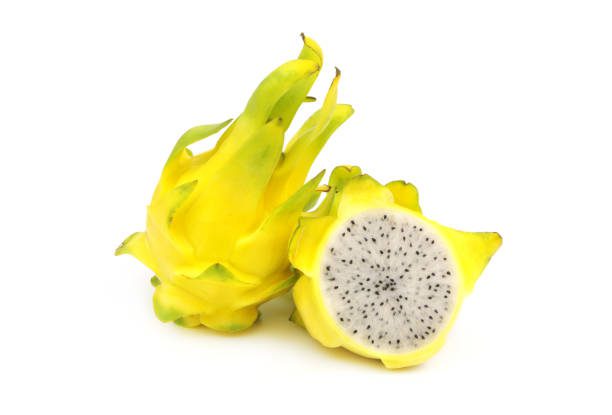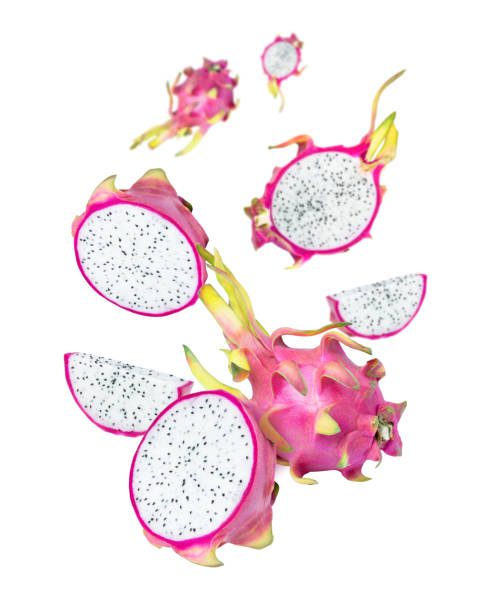This content is for informational and educational purposes only. Always consult a qualified healthcare provider.
Last Updated on February 5, 2024 by Grace Oluchi
Dragon fruit, also known as pitaya, is a tropical fruit that has gained popularity in recent years due to its unique appearance and health benefits. The fruit is native to Central and South America, but it is now widely cultivated in Southeast Asia, particularly in Vietnam and Thailand. In this article, we’ll take a closer look at pitaya, its nutritional value, and how to eat it.
📋 Table of Contents
Appearance and Varieties of Dragon Fruit (Pitaya).
Pitaya is a unique fruit that has a distinctive appearance. It is oval-shaped with a scaly, bright pink or yellow skin. The skin is covered in green or yellowish spikes that give the fruit its dragon-like appearance. The flesh of the fruit is white with small black seeds throughout, and it has a mild, slightly sweet flavor.


There are two main types of pitaya: the white-fleshed variety and the red-fleshed variety. The white-fleshed variety is more common and has a milder flavor, while the red-fleshed variety is sweeter and has a more intense flavor.


Nutritional Value of Dragon Fruit (Pitaya).
Pitaya is a low-calorie fruit that is high in fiber, vitamin C, and antioxidants. A 100-gram serving of pitaya contains just 60 calories, 1 gram of protein, and 13 grams of carbohydrates, including 3 grams of fiber. This makes it a great choice for those who are looking to maintain a healthy weight or lose weight.
Pitaya is also an excellent source of vitamin C, with a 100-gram serving providing 34% of the recommended daily intake. Vitamin C is an important antioxidant that helps to protect the body from damage caused by free radicals. Pitaya is also rich in other antioxidants, such as betalains and carotenoids, which have been linked to a reduced risk of chronic diseases such as heart disease and cancer.
How to Use Dragon Fruit.
Dragon fruit can be used in a variety of ways in your diet. It can be eaten raw, either on its own or added to a fruit salad. It can also be blended into smoothies or used to make juices. Pitaya is also a popular ingredient in Asian cuisine, particularly in desserts.
When choosing dragon fruit, look for fruit that is firm and has bright, even-colored skin. Avoid fruit that has soft spots or bruises. To prepare dragon fruit, simply cut it in half and scoop out the flesh with a spoon. The skin is not edible.
Dragon fruit is a unique and nutritious fruit that can be a great addition to a healthy diet. Its low calorie and high fiber content make it a great choice for weight management, and its high vitamin C and antioxidant content make it a great choice for overall health and disease prevention. So next time you’re at the grocery store, don’t be afraid to give this exotic fruit a try!
Nutritional Facts.
Dragon fruit is a low-calorie and nutrient-dense fruit that is rich in fiber, vitamins, and antioxidants. One cup (227 grams) of diced dragon fruit contains:
- Calories: 136
- Protein: 3 grams
- Fat: 0 grams
- Carbohydrates: 29 grams
- Fiber: 7 grams
- Vitamin C: 9 mg (equivalent to 10% of the daily value)
- Iron: 1 mg (equivalent to 6% of the daily value)
- Magnesium: 85 mg (equivalent to 21% of the daily value)
- Calcium: 20 mg (equivalent to 2% of the daily value)
- Potassium: 436 mg (equivalent to 9% of the daily value)
Pitaya is also a good source of antioxidants, including betalains and carotenoids, which have been linked to a reduced risk of chronic diseases such as heart disease and cancer. Betalains are responsible for the fruit’s vibrant color and have been shown to have anti-inflammatory and anti-cancer properties.
Furthermore, pitaya is low in sugar, which makes it a great choice for those who are watching their sugar intake. Its high fiber content can also help to slow down the absorption of sugar in the body, which can help to stabilize blood sugar levels.
Pitaya is a nutrient-dense fruit that is low in calories and high in fiber, vitamins, and antioxidants. Its nutritional profile makes it a great addition to a healthy diet and can help to support overall health and wellbeing.
Health Benefits.
Pitaya is a tropical fruit that has been linked to several health benefits. Here are some of the health benefits of pitaya:
- Boosts Immune System: pitaya is rich in vitamin C, which is a powerful antioxidant that helps to boost the immune system. A study has shown that consuming dragon fruit can increase the production of white blood cells, which are responsible for fighting off infections and diseases.
- Aids Digestion: pitaya is rich in fiber, which can help to promote healthy digestion. It can also help to prevent constipation and other digestive problems. The high fiber content in dragon fruit can also help to regulate blood sugar levels and reduce the risk of developing type 2 diabetes.
- Reduces the Risk of Chronic Diseases: pitaya is rich in antioxidants, which can help to reduce the risk of chronic diseases such as heart disease and cancer. The betalains in pitaya have been shown to have anti-inflammatory and anti-cancer properties.
- Promotes Healthy Skin: pitaya contains vitamin C, which is essential for the production of collagen, a protein that helps to keep the skin firm and elastic. It also contains carotenoids, which can help to protect the skin from sun damage and premature aging.
- Boosts Energy Levels: Dragon fruit is a good source of carbohydrates, which are the body’s primary source of energy. It also contains magnesium, which is essential for the production of energy in the body.
- Dragon fruit is low in calories and fat, making it a great addition to a weight loss diet. Its sweet and refreshing taste also makes it a great snack or dessert option.
Dragon fruit is a nutrient-dense fruit that can offer several health benefits. Its high fiber, vitamin C, and antioxidant content can help to boost the immune system, aid digestion, reduce the risk of chronic diseases, promote healthy skin, and boost energy levels.
How to Eat It.
Pitaya can be enjoyed in a variety of ways. Here are some tips on how to eat dragon fruit:
- Choose a ripe dragon fruit: Look for a fruit that is evenly colored and free of soft spots or bruises. A ripe dragon fruit should give slightly when pressed.
- Cut the fruit in half: Use a sharp knife to cut the fruit in half lengthwise. The flesh of the fruit should be white with small black seeds scattered throughout.
- Scoop out the flesh: Use a spoon to scoop out the flesh of the fruit. The flesh is edible and has a mild, sweet flavor.
- Eat the fruit as is: Dragon fruit can be eaten on its own as a healthy snack. You can also add it to fruit salads or smoothie bowls for extra flavor and nutrition.
- Use the fruit in recipes: Dragon fruit can be used in a variety of recipes, such as fruit tarts, sorbets, and jams. The fruit’s mild flavor and bright color make it a popular ingredient in many desserts.
- Freeze the fruit: Dragon fruit can be frozen for later use. Simply cut the fruit into small pieces and store in an airtight container in the freezer. Frozen dragon fruit can be used in smoothies or as a healthy snack.
Dragon fruit is a versatile fruit that can be enjoyed in many different ways. Whether eaten on its own or used in recipes, dragon fruit is a healthy and delicious addition to any diet.
The Key Takeaway.
Dragon fruit may be an exotic fruit, but it’s one that’s worth trying. Not only is it a beautiful fruit with a unique appearance, but it’s also packed with antioxidants, fiber, and other nutrients that are beneficial to your health. Whether you eat it on its own, add it to a smoothie, or use it in a recipe, dragon fruit is a delicious and nutritious fruit that’s sure to impress. So why not add this vibrant and flavorful fruit to your next grocery list and experience the many benefits that dragon fruit has to offer!
What is dragon fruit (pitaya)?
Dragon fruit, also known as pitaya, is a tropical fruit that comes from several species of cactus. It has a bright pink or yellow outer skin with green scales, and a white or pink flesh dotted with small black seeds.
What are the health benefits of dragon fruit?
Dragon fruit is a good source of fiber, vitamin C, and antioxidants. It may help promote digestion, boost immune function, and reduce inflammation.
How do you eat dragon fruit?
To eat dragon fruit, simply cut it in half and scoop out the flesh with a spoon. You can also slice it into wedges and peel off the skin. The flesh can be eaten on its own or added to smoothies, salads, or other dishes.
Where can you buy dragon fruit?
It can be found in many grocery stores and specialty food stores, particularly in areas with large Asian populations. It may also be available at farmers markets or online retailers.
How do you know when dragon fruit is ripe?
A ripe dragon fruit will have a bright, even color and be slightly soft to the touch. The scales on the skin should be dry and not brown or wilted.

